My 1st Barber Quarter! Is it Counterfeit? **UPDATED**
Well Folks, in my ten years of detecting I’ve never dug a Barber Quarter.
Not sure if this crusty example qualifies or not? This is really The Good, The Bad, and The Ugly of coin finds.
I went out today knocking on some doors around town trying to score a place to detect.
After about eight houses with no one home, I finally got permission to detect only the front yard (back yard had a dog) of a 1901 house.
After digging nothing but crappe’ for about an hour, I got a signal under a large pine out in the front corner of the lawn. It wasn’t even a good signal, but by this time I was desperate. The dirt was very dry and the pine roots were everywhere. I kept at it, and kept at it until I finally got the item out of the hole. Unfortunately, it snapped in half due to yours truly prying away at the roots. I didn’t have my pin pointer today, because I had to send it back.
I thought I had dug some sort of aluminum token at first, but it weighed too much to be aluminum. I had no idea what I had so I put it in my pouch. When I got home I cleaned it off with some water and saw a reeded edge and a date of “1895(?)” on it. I saw “Quarter Dollar” on it and some other details but still had no idea? I pulled out my trusty coin book and figured out it was a Barber Quarter! Yahoo!!!
I pulled out my trusty coin book and figured out it was a Barber Quarter! Yahoo!!!
Now for the questions:
1) Why does this coin not look like silver? It can be cracked in half like old pewter or lead. It has more of a white chalky appearance.
2) Why is it larger in diameter than a silver Washington quarter? They should both be 24.3mm.
3) The diameter of the Barber is larger than the Washington, but as you can see, it weighs LESS. Should be 6.25 g.
4) Was this a counterfeit coin, or was it toasted in a fire perhaps? Would a silver coin grow to this size and also crumble?
5) Does it look like 1895? 1893? Or 1899? I think it’s 1895.
Sorry for the long-winded post, but I’m not sure if this coin should count as my first ever Barber quarter?
Thanks for looking,
MM
11/17/2013 ***UPDATE***
O.K. Folks, I received the silver test kit in the mail and conducted the test to find out if this crusty looking over-sized Barber quarter was:
1) Previously in a fire causing this kind of damage, or
2) A counterfeit made of some other type of metal.
Drum roll please..........
Actually, I didn't have a drum, but attached is a video of the actual test done, and a photo.
http://www.youtube.com/watch?v=v4wzfAKuqug&feature=youtu.be
Thank to all of you for your guesses, info, and input on this mystery coin.
I guess I CAN finally cross a real Barber quarter off my list.
-MM-
11/18/2013 ***Another UPDATE***
Well, here's the results of me filing two areas on the Barber. I filed the inside edge and a corner of the back of the coin. I included a filed down Merc dime for a color comparison, since it's tough to tell in the photos.
I guess now we know what can happen to a toasted silver coin. It's kind of like a apple turnover. Crusty on the outside and sweet in the middle.

-MM-
Well Folks, in my ten years of detecting I’ve never dug a Barber Quarter.
Not sure if this crusty example qualifies or not? This is really The Good, The Bad, and The Ugly of coin finds.
I went out today knocking on some doors around town trying to score a place to detect.
After about eight houses with no one home, I finally got permission to detect only the front yard (back yard had a dog) of a 1901 house.
After digging nothing but crappe’ for about an hour, I got a signal under a large pine out in the front corner of the lawn. It wasn’t even a good signal, but by this time I was desperate. The dirt was very dry and the pine roots were everywhere. I kept at it, and kept at it until I finally got the item out of the hole. Unfortunately, it snapped in half due to yours truly prying away at the roots. I didn’t have my pin pointer today, because I had to send it back.

I thought I had dug some sort of aluminum token at first, but it weighed too much to be aluminum. I had no idea what I had so I put it in my pouch. When I got home I cleaned it off with some water and saw a reeded edge and a date of “1895(?)” on it. I saw “Quarter Dollar” on it and some other details but still had no idea?
 I pulled out my trusty coin book and figured out it was a Barber Quarter! Yahoo!!!
I pulled out my trusty coin book and figured out it was a Barber Quarter! Yahoo!!!Now for the questions:
1) Why does this coin not look like silver? It can be cracked in half like old pewter or lead. It has more of a white chalky appearance.
2) Why is it larger in diameter than a silver Washington quarter? They should both be 24.3mm.
3) The diameter of the Barber is larger than the Washington, but as you can see, it weighs LESS. Should be 6.25 g.
4) Was this a counterfeit coin, or was it toasted in a fire perhaps? Would a silver coin grow to this size and also crumble?
5) Does it look like 1895? 1893? Or 1899? I think it’s 1895.
Sorry for the long-winded post, but I’m not sure if this coin should count as my first ever Barber quarter?
Thanks for looking,
MM
11/17/2013 ***UPDATE***
O.K. Folks, I received the silver test kit in the mail and conducted the test to find out if this crusty looking over-sized Barber quarter was:
1) Previously in a fire causing this kind of damage, or
2) A counterfeit made of some other type of metal.
Drum roll please..........
Actually, I didn't have a drum, but attached is a video of the actual test done, and a photo.
http://www.youtube.com/watch?v=v4wzfAKuqug&feature=youtu.be
Thank to all of you for your guesses, info, and input on this mystery coin.
I guess I CAN finally cross a real Barber quarter off my list.
-MM-

11/18/2013 ***Another UPDATE***
Well, here's the results of me filing two areas on the Barber. I filed the inside edge and a corner of the back of the coin. I included a filed down Merc dime for a color comparison, since it's tough to tell in the photos.
I guess now we know what can happen to a toasted silver coin. It's kind of like a apple turnover. Crusty on the outside and sweet in the middle.

-MM-
Attachments
-
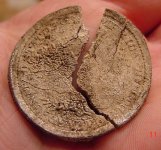 MVC-054F.JPG96.7 KB · Views: 330
MVC-054F.JPG96.7 KB · Views: 330 -
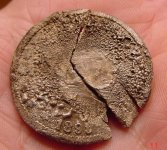 MVC-055F.JPG94.7 KB · Views: 308
MVC-055F.JPG94.7 KB · Views: 308 -
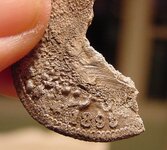 MVC-056F.JPG82.3 KB · Views: 288
MVC-056F.JPG82.3 KB · Views: 288 -
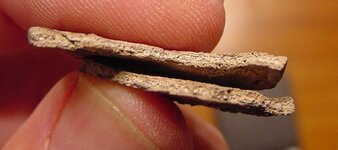 MVC-057F.JPG41.3 KB · Views: 267
MVC-057F.JPG41.3 KB · Views: 267 -
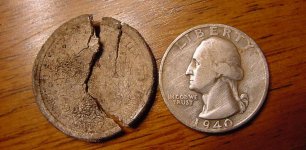 MVC-058F.JPG79.2 KB · Views: 268
MVC-058F.JPG79.2 KB · Views: 268 -
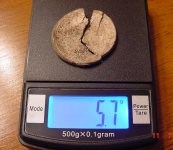 MVC-063F.JPG102.4 KB · Views: 227
MVC-063F.JPG102.4 KB · Views: 227 -
 MVC-062F.JPG91.1 KB · Views: 237
MVC-062F.JPG91.1 KB · Views: 237 -
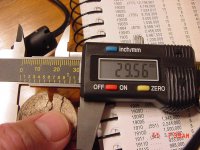 MVC-061F.JPG126.8 KB · Views: 227
MVC-061F.JPG126.8 KB · Views: 227 -
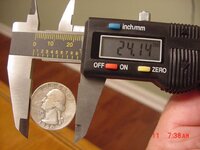 MVC-060F.JPG108.7 KB · Views: 267
MVC-060F.JPG108.7 KB · Views: 267 -
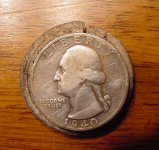 MVC-059F.JPG70.6 KB · Views: 266
MVC-059F.JPG70.6 KB · Views: 266 -
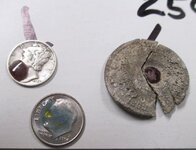 IMG_0283.JPG65.3 KB · Views: 113
IMG_0283.JPG65.3 KB · Views: 113 -
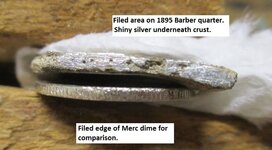 IMG_0284.JPG84 KB · Views: 96
IMG_0284.JPG84 KB · Views: 96 -
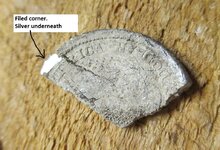 IMG_0285.JPG141.1 KB · Views: 101
IMG_0285.JPG141.1 KB · Views: 101
Last edited:
Upvote
5






 if you get one before the wedding I'll give you a great drink special and that first beer will only cost ya a quarter.
if you get one before the wedding I'll give you a great drink special and that first beer will only cost ya a quarter.

 Although even today kids don't know what a half dollar, Sac dollar, or modern gold dollar are if you try to use them to pay for something. LOL
Although even today kids don't know what a half dollar, Sac dollar, or modern gold dollar are if you try to use them to pay for something. LOL





